|
The Tactical Helicopter Group (THG)
consists of 3 Squadrons, each operating a different type of
helicopter. In use are the Alouette 3, AS352U2 Cougar, the CH47D Chinook and the AH-64D Apache.
Each type requires its own flight gear. This article does not
include the AH-64 gear, as this is to be described in a
different article.
The
Coverall
In use is an aramid with Kevlar coverall
in green and a desert (tan) version. Besides that, a two piece standard desert BDU is worn by pilots. Main reason is not to stand out among the other soldiers when having to exit the helicopter in an emergency landing. (hostile area) The flying suit has two pen pockets (on each arm) and survival knife pouch on the left
leg. The position of this pouch turned out not to be correct
for the fighter pilots. The pouch is on the inner side of the
leg and with a knife in it, it will block the bloodstream in
the leg when the g-pants are
inflated… (manufacturers include Albatross, Seyntex, KLM clothing and Texplorer GMBH)
Survival Vest
For the last decade three types of vests were
used on the helicopters, the first being the Autoflug GmbH
type that looks like the SRU-21P. With a LPU-10 as life preserver. The Autoflug was replaced
with the UK made Beaufort Mk.3NL. This type of vest has an
integrated life preserver (removable). It also features straps that are
used to pull the pilot out of the water or the wreckage of his
helicopter. Both the vest types contain the usual survival items
such as a radio, knife, revolver, strobe light, flares and
more. The newer versions of this vest has leather patches sewn to the pockets for increased protection against damage. (see separate article on this website) At the moment the Helicopter Group is testing the Beaufort Mk.61 vest, that's already in use on the Apache in a desert version.
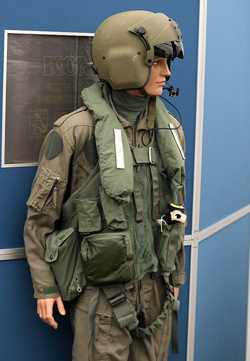
Immersion Suit
When (sea) water
temperatures are below 10 degrees Celsius, an immersion suit
is worn. This suit has leg, arm and neck seals to prevent
water from entering. On the legs there are pockets to store
maps.
Helmets
Gentex SPH-4 "Cobra",
this grey helmet has a single visor kit with the lock knob on
the left-hand side. It was used on the Bo-105CB and Alouette 3 and is now out of service.
The helmet has a black Styrofoam liner with TPL. A boom mike
is used. Being a single visor set-up, the change of visor had
to be done in the shop. This gave problems with dusk
operations, as flying without visor was restricted to 60 knots.
While operating in Kosovo, some Cobra helmets were fitted with
the SPH-5 dual visor kit. The fact that SPH-5 visor kits are
green did not seem to be a problem. The modified single visor
housing could also be fitted with the Philips night vision
goggles. These helmets have been replaced by the
HGU-56/P.
SPH-5,
This is a dual visor helmet almost similar to the SPH-4 used
in the US Army. This helmet can also be equipped with the
ANVIS system. Due to the noise produced by the CH47D Chinook,
some pilots suffered from hearing problems. The SPH-5 was not
able to reduce noise to a level on which normal conversation
was possible. The communications device in both the AS352U2
and the CH47D had to be switched on to the highest sound level
to be heard. To prevent further problems it was decided to
order the HGU-56/P and also replace this helmet.
HGU-56/P, This new
dual visor helmet is also standard in the US Army. Made of
advanced graphite composite materials, this helmet can provide
better protection to the pilot. The new ear cups are providing
a better noise reduction to protect from hearing loss. This
helmet also features a TPL. In the Netherlands
Airforce, the loadmasters are using a blast shield in front of
the helmet (maxillofacial shield). This makes hanging out of a helicopter much
easier. With this shield, windblast does not interfere with
the microphone and communications. During normal operations it
became clear that the boom of the microphone, as used on this
helmet, suffers from breaking. There are plans to replace the
boom with the older type. It is also possible to connect the
helmet to an air-conditioning unit. All the helmets are now fitted with the CEP kit. On this helmet the
AN/AVS-6(V)2 and ANVIS-9 can be used as well. An in dept article on
the ANVIS system can also be found on this website. The latest developments include an ANVIS-HUD system that offers the necessary information for the pilot in front of his ANVIS. |
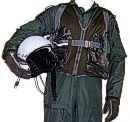
Cobra helmet,
AFG-1N-3

the SPH-4
"Cobra" helmet
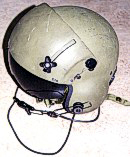
the SPH-5
helmet
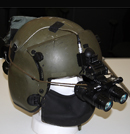
HGU-56 with blast shield
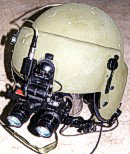
HGU-56 with
ANVIS
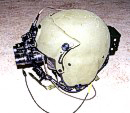
Another view of
HGU-56 |